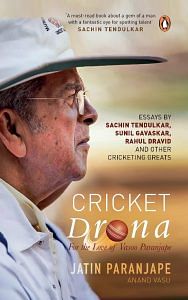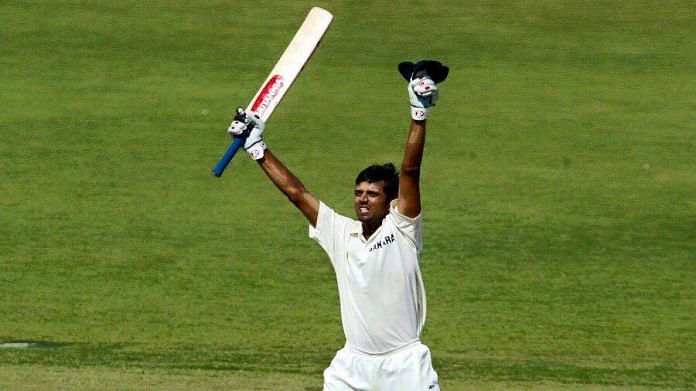My month with Mr Paranjape? Well, he had a huge reputation in the game and I was only fourteen years old at the time. What I remember from that month was his sheer passion for cricket. He was truly, deeply in love with the game. We’d have a morning session and an evening session, and we’d go home in the middle for lunch or whatever, but he wouldn’t leave the ground. He might take a nap in the dressing room, but he was right there. You saw the excitement in his eyes when we did well. If a young bowler was swinging the ball or spinning it hard, or if a batsman played a cover drive, it genuinely made him happy. At that age, the lightest pat on the back from a coach like him made all the difference to me.
For a boy of fourteen who wants to absorb as much as possible, learn as much as possible, there’s nothing more important than a source of inspiration. And for me, that month was all about getting inspired. After it was over, I walked away thinking, ‘Hey, this is the standard I’ve seen in players in India. I’m probably not there yet, but I need to get there, and I can do it.’ If I want to be good at cricket, I said to myself, then I am going to need to develop a passion for the game.
I also felt reassured because Mr Paranjape never gave me the sense that he was intervening too much technically or interfering with how I tried to play the game. I was the second wicketkeeper in the group. I could bat a bit, but I was there primarily as the second wicketkeeper. And I was told by both Mr Paranjape and Hanumant Singh: ‘You’re going to play for India, but not as a wicketkeeper.’
When I attended an under-17 camp a year later, Hanumant Singh took me aside for a chat and told me to look in the mirror and think hard about whether I wanted to keep or not. Back in those days the wicketkeeper typically batted at number six, so the chances I got were also limited. I was fortunate to score 70-odd in a zonal match where I ran out of partners. Then, someone in South Zone saw something in me and moved me up the order. So coaches have been very crucial to my growth as a cricketer.
Also read: Rahul Dravid’s 5-point wishlist to make sports available for every Indian
Coming back to the subject of coaching. One of the differences between the old approach and the new one is that today you have to pay attention to larger groups of players than previously. You have to think about kids who are not as good as those to whom the game comes naturally or easily. You have a duty of care to everyone in the group. It is impossible to give everyone the same kind of attention or opportunities, but at least in your mind you have to be aware of that duty of care. As long as you have that as your philosophy, your guiding principle, you’ll be okay. Of course, you will get things wrong and won’t be able to keep everyone happy, but that’s not how you judge a success or failure in coaching.
It’s also important to recognize the stresses and pressures that children are under now. They choose cricket as a profession early on, and the decisions you take about them could be life-altering. It’s not easy but you have to take those calls. In a country like India, more and more kids are taking up cricket every day, the pool is getting wider and a lot more talent is emerging from smaller towns and cities. This can lead to a situation wherein a player may be very good at his level or in his local circuit but may struggle to get opportunities at a higher level, simply because there are other players who are better than him. A coach has to handle such situations with empathy, understanding and care.
There have been coaches working at the grassroots level—men like Ramakant Achrekar, Paranjape, Hanumant and Tarapore—who gave their lives to the game. Tarapore got paid by the Karnataka State Cricket Association but it was not a significant amount, and from the Bangalore United Cricket Club he drew nothing. And yet he was there every day. He was the first in, to ensure the nets had been put up, the matting was in order; and then we would show up, have a session and head off to school or college or whatever, but he would still be there, making sure all was as it should be. First in and last out, every single day. And that did eventually take its toll on his health: he had to have his leg amputated owing to complications caused by varicose veins. The impact and influence of such coaches cannot be measured.
It is no wonder that Bombay of a particular era was such a dominant force for such an extended period in Indian cricket. The strength of Bombay cricket was built on the shoulders of these coaches and was the product of their passion to promote and nurture young talent. It would be fair to say that in those days, a cricketer from Bombay had his basics and fundamentals covered better than cricketers from other parts of the country. This was because of these committed coaches, who were also selflessly investing their time and efforts into clubs, colleges and schools.
Also read: A new era begins for cricket stats, where quality of opposition & pressure will count
As cricket gets bigger, more people are getting into coaching as well, and what worries me sometimes is the quality of these people that the game is attracting. That is where the influence of someone like Paranjape—who inspired me first as a cricketer and inspires me now in my coaching career—comes in. Back then, knowledge was power and it made people like Paranjape so invaluable. But today, in our world of video and YouTube, knowledge is easily accessible. So what is of crucial importance now is the quality of people imparting that knowledge. Are those who guide us today as inspirational—through their words and deeds—as those who guided us in the past?
Becoming a coach has had a definite impact on me. It has enabled me to see things a little more holistically and to have more empathy for the players; it has taught me new things about myself and allowed me to learn more about younger players; it has forced me to put myself in other people’s shoes and look at the game as they might. When you’re a professional sportsperson, you are thinking so much about your own performance and what you can contribute that you get into a bit of a tunnel-vision mode. Coaching has opened that up for me completely.
‘What I Saw in Rahul…’ — Vasoo Paranjape
He came as a keeper-batsman, and I requested him to focus on his batting. I also wrote to C. Nagraj, the Karnataka State Cricket Association secretary at the time, to ensure that coaches in Karnataka also follow the same approach with him if possible. Rahul was a very disciplined and serious boy, always first at the nets and hanging on to every word that was said to him. He also had a natural cricketing brain, and I remember thinking that he would make a good captain, albeit a very studious one.
He was always a batsman who valued his wicket, even as a young player, and he was very classy and ‘neat’ in the way he went about his batting. You could see his hunger to play a long innings, and I was confident that with Keki Tarapore as his coach in Bangalore, he was in solid hands. I tried to touch up his game a little, without doing anything drastic with his technique, not that anything drastic needed to be done. I emphasized on building an innings and other tactical tools to help him approach innings and match situations better. I also stressed that it was extremely important that he enjoy his batting.
 This excerpt from Cricket Drona: For the Love of Vasoo Paranjape by Jatin Paranjape and Anand Vasu has been published with permission from Penguin Random House India.
This excerpt from Cricket Drona: For the Love of Vasoo Paranjape by Jatin Paranjape and Anand Vasu has been published with permission from Penguin Random House India.







Nicely written wise words
Very well written